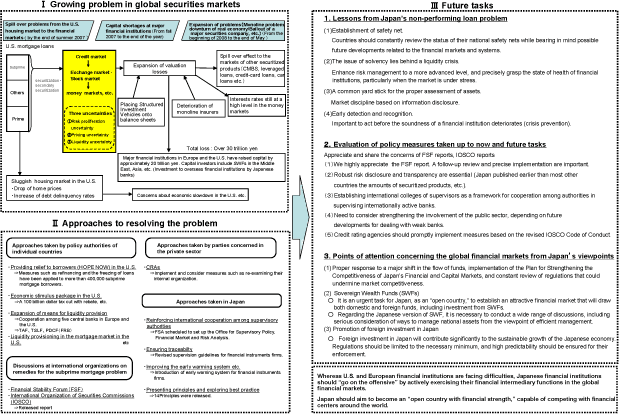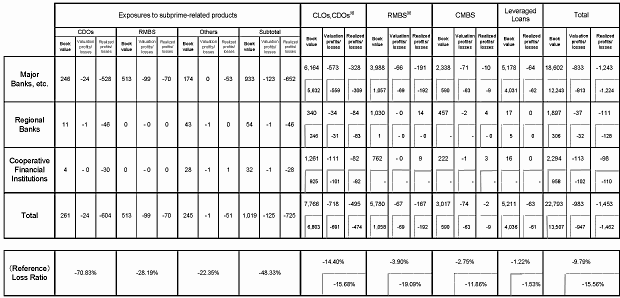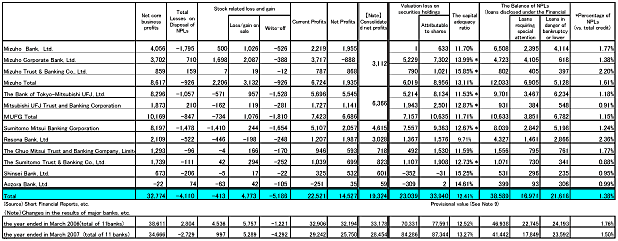 |
 |
Minister Watanabe attended the World Economic Forum on East Asia (June 15) |
|
Statements, Speeches & Material
In this corner, we post statements and speeches made by the Minister, the Senior Vice Minister, the Parliamentary Secretary and FSA officials, as well as presentation material they used.
Official Statements
FSA Statement following the enactment of the Bill for Amendment of the Financial Instruments and Exchange Act, etc
Speeches
Progress in the FSA's Efforts toward "Better Regulation" speech by Takafumi Sato, Commissioner of the Financial Services Agency at the International Bankers Association
[Featured]
The Financial Markets Strategy Team Releases
"Second Report ∼Toward an Open Country with Financial Strength∼"
On June 12, 2008, the Financial Markets Strategy Team (chaired by Yoshikazu Takao, executive director, Asahi Life Asset Management Co.) released its second report.
Since it released its first report in November 2007, the Financial Markets Strategy Team, an advisory group to the Minister for Financial Services has held nine sessions, focusing mainly on issues related to the subprime mortgage problem, whose effects have spread through the global financial markets. Based on these discussions, the group has drawn up its "Second Report ∼Toward an Open Country with Financial Strength∼."
This report provides a follow-up review of how far the subprime mortgage problem has widened and deepened since the release of the first report and addresses the following points of discussion:
(1) Lessons from Japan's non-performing loan problem
((i) Need to establish a safety net quickly, (ii) the issue of solvency that underlies a liquidity crisis, (iii) the need for a common yardstick for asset assessment and (iv) the importance of detecting and recognizing problems at an early stage
(2) Evaluation of policy measures and recommendations included in the reports issued by the FSF (Financial Stability Forum) and the IOSCO (International Organization of Securities Commissions and future tasks
(3) Points for attention concerning the global financial markets from Japan's viewpoint
((i) Appropriate response to changes in the flow of funds, (ii) promotion of the Plan for Strengthening the Competitiveness of Japan's Financial and Capital Markets (Better Market Initiative), (iii) constant review of various institutional frameworks that restrict competition, (iv) studies on sovereign wealth funds and (v) promotion of foreign investment in Japan
With due consideration to the above points of discussion, the second report sends out the following messages regarding the actions Japan should take:
(1) As U.S. and European financial institutions face a difficult situation, Japanese financial institutions should "go on the offensive" by actively exercising their financial intermediary functions in the global financial markets.
(2) Japan should aim to become an "open country with financial strength," capable of competing with financial centers around the world in terms of the quality of financial services, institutional infrastructure, talent and other elements.
The Financial Services Agency (FSA) has already implemented the following measures in response to the first report:
(1) Revising the guidelines for supervision in order to improve the traceability of underlying debts with regard to trading in securitized products
(2) Introducing an early warning system regarding financial instruments business operators
(3) Promoting the expansion and enhancement of arrangements and procedures for precisely grasping market developments
(4) Agreeing with private financial institutions on principles (publication of the 14 principles)
From now on, the FSA intends to implement these measures further and to seek to reflect the various tasks and points of attention set forth in the second report in the conduct of its financial regulation as much as possible.
* For details, please go to the FSA's Website and access "Financial Markets Strategy Team Releases "Second Report - "Toward an Open Country with Financial Strength."
Financial Markets Strategy Team Second Report
∼Toward an Open Country with Financial Strength∼
[TOPICS]
FSA discloses exposure of Japanese deposit-taking institutions to subprime-related products and securitized products
On June 6, 2008, the FSA disclosed the amount of subprime-related products held by Japanese deposit-taking financial institutions and that of their valuation realized profits/losses as of the end of March. This was the third of such information disclosure, after the disclosure of these dataas of 2008 the end of September and December 2007.
Subprime-related products held by Japanese deposit-taking financial institutions as of the end of March totaled some 1.19 trillion yen, with a combined valuation and realized losses on these products amounting to some 850 billion yen.
The disclosure at this time also covered the amount of holdings and other data regarding securitized products not directly related to subprime mortgages (collateralized debt obligations (CDOs), residential mortgage-backed securities (RMBSs), commercial mortgage-backed securities (CMBSs), leveraged loans, etc.) in line with the leading disclosure practices summarized in a report issued by ![]() the Financial Stability Forum (FSF) on April 11, 2008
the Financial Stability Forum (FSF) on April 11, 2008![]() .
.
Securitized products held by Japanese deposit-taking financial institutions totaled some 22,793 billion yen, with combined valuation and realized losses on these products amounting to some 2,436 billion yen.
This means that losses on securitized products other than subprime-related ones amounted to some 1,586 billion yen, indicating that the subprime mortgage problem has affected various types of securitized products.
In light of these data, the FSA believe that the turmoil in the global financial markets triggered by the subprime mortgage problem has had substantial effects on Japanese financial institutions.
However, the FSA believes that, at this point in time, the subprime mortgage problem is unlikely to impact seriously on Japan's financial system for the following reasons:
(i) Compared with large and complex financial institutions (LCFIs) in the United States and Europe (each of which incurred losses ranging from 3 trillion to 4 trillion yen), Japanese financial institutions have experienced only limited damage.
(ii) The size of Japanese financial institutions' losses is small enough to be covered by their term profits, allowing them to secure net profits.
The FSA has already clarified the extent of the effects of the subprime mortgage problem on Japanese deposit-taking financial institutions by disclosing data on subprime-related products held by these institutions on an aggregate basis under a unified standard, ahead of the world's other countries.
We believe that efforts like this will help to promote a precise understanding of the impact of the subprime mortgage problem on Japan's financial system and to dispel the uncertainty over the global financial markets amid the continued turmoil.
The disclosure at this time represents a step forward in our efforts to enhance our dissemination of information as it takes account of the leading disclosure practices recommended by the FSF report and disclosures by individual financial institutions. We will continue to improve the public access to the current state of the financial system and the FSA's concept of financial regulation.
* For details, please go to the FSA's Website and access "Exposures of Japanese deposit-taking institutions to subprime-related products and securitized products based on the leading practices summarized in the FSF report" (June 6, 2008) at the "Press Releases" section.
Exposures of Japanese deposit-taking institutions to subprime-related products
Figures in brackets are as of the end-December 2007 (Billion Yen)
Apart from the above figures, there are valuation/realized losses at some Japanese financial institutions for securitized products not directly related to subprime loans, as global market turmoil has been broadly affecting financial markets, especially in the U.S. and Europe.
Note 1: "Subprime-related products" are asset-backed securities (ABSs) backed by subprime loans or collateralized debt obligations (CDOs) and other financial products referencing these ABSs. "Subprime-related businesses" are the businesses in which firms produce subprime-related products. The above figures do not include the exposures to subprime-related products through investment trusts.
Note 2: "Major Banks, etc" include major banks (Mizuho Bank, Mizuho Corporate Bank, Mizuho Trust Bank, Bank of Tokyo-Mitsubishi UFJ, Mitsubishi UFJ Trust Bank, Sumitomo Mitsui Banking Corporation, Resona Bank, Chuo-Mitsui Trust Bank, and Sumitomo Trust Bank), Norinchukin Bank, Shinsei Bank, Aozora Bank, Citibank Japan, banks of new type, foreign trust banks and others.
Note 3: "Cooperative Financial Institutions" include Shinkin Banks including Shinkin Central Bank, Credit Cooperatives including The Shinkumi Federation Bank, Labour Banks including The Rokinren Bank, Prefectural Banking Federations of Agricultural Cooperatives, and Prefectural Banking Federations of Fishery Cooperatives. This does not include Japan Agricultural Cooperatives, etc.
Note 4: The above figures are based on interviews with individual institutions, etc., and thus can be further revised in the process of examination by each institution.
Note 5: Subprime-related exposures at some securities firms are included in the figures for "Major Banks, etc." as those figures are on a consolidated basis.
Exposures of Japanese deposit-taking institutions to securitized products based on the leading practices summarized in the FSF report
(As of the end-March 2008) (Billion Yen)
Figures in inner columns represent the underlying assets of which were originated abroad.
* Excluding subprime-related products
Note 1: The above figures are based on interviews with individual institutions, and thus can be further revised in the process of examination by each institution.
Note 2: "Loss Ratio" is the percentage of sum of valuation profits/losses (as of the end-March), additional provisions and impairment (during the period) to the book value as of the beginning of the period.
Note 3: CDOs include the exposures to SIVs.
Note 4: RMBS does not include GSE MBS.
Note 5: While the definition of leveraged loans can vary depending on each financial institutions, it generally refers to loans to low-rated companies, including loans made for mergers and aquisitions.
Note 6: Apart from above figures, losses on CDS transactions with monoline insurers (about 30 billion yen) have been reported.
Following the announcements by major banks, etc.1 of their financial results for FY2007, the FSA compiled the figures, etc. announced by the respective banks and disclosed them on May 20, 2008.
Below is a summary of the financial results of the major banks, etc. for FY 2007.
1. Status of Profit
The net core business profits, which represent profits from core banking operations, of major banks, etc. totaled 3.3 trillion yen in the fiscal year ended in March 2008, down 0.2 trillion yen from the fiscal year ended in March 2007. Although the profit margins and the balance of outstanding loans increased, the increases were limited. Meanwhile, fee revenues declined due to the deterioration of market conditions and expenses grew due to spending related to "forward-looking" measures intended to promote future growth. A combination of these factors apparently reduced their net core business profits.
The banks' net profits in the fiscal year ended in March 2008 totaled 1.5 trillion yen, down 1.1 trillion yen from the fiscal year ended in March 2007. Although losses related to non-banking operations declined year-on-year, losses related to subprime-related products and to the write-down of stock holdings and credit-related expenses grew, apparently leading to a decrease in net profits.
2. Status of financial soundness
The non-performing loan ratio of major banks, etc. remained low at 1.4% in the fiscal year ended in March 2008, down 0.1 percentage point from the fiscal year ended in March 2007.
Their capital adequacy ratio, which has been calculated under the Basel II formula since the fiscal year ended in March 2007, stood at 12.3%, down 1.0 percentage point from the fiscal year ended in March 2007. The decline reflected a decrease in unrealized profits on stock holdings, among other factors.
As shown above, profits of major banks, etc. declined due to subprime-related losses and other factors. However, we believe that their financial health remains sound in light of the continued low level of their non-performing loan ratio and the sufficient level of their capital adequacy ratio.
1. "Major Banks, etc." refers to Mizuho Bank, Mizuho Corporate Bank, Mizuho Trust Bank, Bank of Tokyo-Mitsubishi UFJ, Mitsubishi UFJ Trust Bank, Sumitomo Mitsui Banking Corporation, Resona Bank, Chuo-Mitsui Trust Bank, Sumitomo Trust Bank, Shinsei Bank and Aozora Bank.
Major banks' non-consolidated financial results for the year ended in March 2008 «based on Preliminary Announcement»
(Unit:100 million yen、%)
Note
- Figures less than a unit have been rounded up to the nearest whole number.
- The asterisks refer to those of internationally operating banks
- [Reference] Consolidated net profits include those of holding companies (Mizuho Financial Group, Inc., Mitsubishi UFJ Financial Group, Sumitomo Mitsui Financial Group, Resona Holdings, Inc., Chuo Mitsui Trust Holding, Inc. ) or banks (The Sumitomo Trust & Banking Co., Ltd., Shinsei Bank, Ltd., Aozora Bank, Ltd.)
- Figures of real operating profits, total losses on disposal of NPLs, stock related loss and gain, current profits, net profits, valuation loss on securities holdings for The Bank of Tokyo-Mitsubishi UFJ, Ltd. include those which are transferred to subsidiary companies, the figures of Chuo Mitsui Trust and Banking Company, Limited include those of its subsidiary companies for stockholding.
- Figures of the balance of NPLs and the percentage of NPLs for the Bank of Tokyo-Mitsubishi UFJ, Ltd. include those which are transferred to subsidiary companies for corporate revitalization.
- Positive figures in the total losses on disposal of NPLs and in the write-off of stock related loss and gain indicate gains, while negative figures in these refer to losses.
- The capital adequacy ratio is calculated based on Basel II since the year ended in March of 2007.
- The capital adequacy ratio of Resona Bank. Ltd. has not been released as of May 20, but is to be officially posted later.
- The capital adequacy ratio of 11 banks has been estimated based on the calculation including Resona's figures in the September quarter 2007, since Resona Bank did not released new figures yet (The ratio is to be recalculated as soon as Resona releases the figures of the year ends in March 2008).
Following the announcements by regional banks1 of their financial results for FY2007, the FSA aggregated the figures2, etc. announced by the respective banks and disclosed them on May 30, 20083.
Below is a summary of the financial results of regional banks for FY2007.
1. Profit Status
The net core business profits of regional banks in the fiscal year ended in March 2008 declined by 203.4 billion yen from the fiscal year ended in March 20074 to 1,799.4 billion yen, mainly due to the deterioration of the balance of profits and losses related to government and other bonds.
Their net profits decreased by 165.5 billion yen from the fiscal year ended in March 2007 to 640.1 billion yen despite a decline in losses related to the disposal of non-performing loans, as net core business profits dropped.
(Unit: billion yen)
| FY ended in March 2006 |
FY ended in March 2007 |
FY ended in March 2008 |
||
|---|---|---|---|---|
| Net core business profits | 1,986.4 | 2,002.8 | 1,799.4 | |
| Interest income | 4,460.7 | 4,476.8 | 4,512.5 | |
| Commission income | 602.5 | 655.0 | 602.9 | |
| Bond-related profits/losses | -58.5 | -44.1 | -161.6 | |
| Losses related to disposal of non-performing loans(-) | -642.7 | -773.0 | -711.1 | |
| Net profits | 1,018.6 | 805.6 | 640.1 | |
| (Reference) | (Unit: trillion yen) |
|---|
| FY ended in March 2006 |
FY ended in March 2007 |
FY ended in March 2008 |
|
|---|---|---|---|
| Loans | 187.4 | 192.5 | 197.6 |
2. Trend of the Capital Adequacy Ratio
The capital adequacy ratio of regional banks stood at 10.3%, essentially unchanged from the fiscal year ended in March 2007.
| FY ended in March 2003 |
FY ended in March 2004 |
FY ended in March 2005 |
FY ended in March 2006 |
FY ended in March 2007 |
FY ended in March 2008 |
|
|---|---|---|---|---|---|---|
| Capital adequacy ratio (%) | 9.1 | 9.0 | 9.4 | 9.8 | 10.4 | 10.3 |
3. Status of Non-Performing Loans
The non-performing loan ratio stood at 3.7%, less than half of the peak level (8.3% in the fiscal first half ended in September 2002).
| FY ended in March 2003 |
FY ended in March 2004 |
FY ended in March 2005 |
FY ended in March 2006 |
FY ended in March 2007 |
FY ended in March 2008 |
|
|---|---|---|---|---|---|---|
| Non-performing loan ratio (%) | 7.8 | 6.9 | 5.5 | 4.5 | 4.0 | 3.7 |
| Amount of non-performing loans (Unit: trillion yen) | 14.7 | 12.8 | 10.4 | 8.7 | 7.8 | 7.5 |
* The non-performing loan ratio and the amount of non-performing loans peaked in the fiscal first half ended in September 2002, at 8.3% and 15 trillion yen, respectively.
1. As of the fiscal year ended in March 2008, there were a total of 110 regional banks, including 64 regional banks, 45 second-tier regional banks and Saitama Resona Bank. As of the fiscal year ended in March 2007, there were a total of 111 regional banks, including 64 regional banks, 46 second-tier regional banks and Saitama Resona Bank. As of the fiscal year ended in March 2006, there were a total of 112 regional banks, including 64 regional banks, 47 second-tier regional banks and Saitama Resona Bank.
2. Figures those on a solo basis, but those of non-performing loans include those transferred to subsidiaries for corporate revitalization.
3. Figures are as of May 30,2008, but could be changed due to future revisions to the financial results.
4. Figures as of the fiscal year ended in March 2008 and 2007 may differ from those the FSA published in the past, as some banks revised their results.
[International Affairs]
Yoshimi Watanabe, then Minister for Financial Services, attended the World Economic Forum on East Asia in Kuala Lumpur, Malaysia on June 15 and participated in a panel discussion on global economic leadership.
In the panel discussion, Minister Watanabe engaged in frank exchanges of views with Vietnamese Minister of Finance Vu Van Ninh, former Indian Minister of Finance Yashwant Sinha and other officials about issues such as how the global financial market turmoil has affected the Asian economy and whether Asia can lead global economic growth. Minister Watanabe actively provided explanations and expressed opinions on matters such as the lessons Japan has learned from its past financial crisis and the direction of the reform to be pursued by Japan in the future.
At a luncheon after the panel discussion, Minister Watanabe talked with the Minister, Ninh, who sat next to him. Later, Mr Watanabe held separate meetings with the Indonesian Minister of Trade, Mari Pangetsu, and the Governor of Bank Negara Malaysia (the central bank of Malaysia), Zeti Akhtar Aziz.
In the series of talks with these officials, Minister Watanabe exchanged views about economic and financial developments in their respective countries, such as the effects of inflation due to the surge in the prices of primary goods.
 |
 |
Minister Watanabe with Indonesian Minister of Trade Pangetsu |
Minister Watanabe with Bank Negara Malaysia Governor Zeti |
In the conferences and meetings he attended, Minister Watanabe pointed out that Japan and other Asian countries are "in the same boat" the FSA intends to strengthen our cooperation with Asian countries based on this perception.
The Fifth Japan-EU Monitoring Meeting on Developments in Accounting and Auditing Issues was held in Paris on May 26, 2008.
These monitoring meetings have been held since November 2006 between the FSA and the European Commission (EC), the executive branch of the European Union (EU), with a view to monitoring the progress status of programs for achieving convergence between the accounting standards adopted in Japan and the EU and discussing the oversight of audit firms and other audit-related issues.
Regarding accounting standards, the two sides discussed developments related to the EC's planned equivalence assessment and enhancement of the governance over the International Accounting Standards Committee Foundation (IASCF).
(Note 1) In the EU, EU companies that issue securities (public offerings/listings) have been obligated since 2005 to adopt the International Financial Reporting Standards (IFRS). In 2009 and later, third-country companies that issue securities (public offerings/listings) and raise funds in the EU will be obligated to adopt the IFRS or standards equivalent thereto. Therefore, the EC intends to complete the assessment of the equivalence between the IFRS and third-country GAAPs (Generally Accepted Accounting Principles) by the mid-2008.
Regarding the assessment of the equivalence by the EC, the two sides recognized as encouraging the assessment of the Japanese GAAP that was proposed in a working paper, issued by the EC in April this year, concerning the equivalence of accounting standards adopted by Japan, the United States, China, Canada and South Korea.
(Note 2) Regarding Japanese GAAP, it has been proposed that "by June 2008 the Commission should consider Japanese GAAP equivalent unless there is no adequate evidence of the ASBJ achieving to timetable the objectives set out in the Tokyo Agreement."
(Note 3) In addition, the EC in June published a draft amendment to the relevant EC regulation, which states that it is appropriate to regard the Japanese GAAP as equivalent to the IFRS in 2009 and later.
Furthermore, the two sides shared the view that given the increasing use of the IFRS around the world and the growing global trend of convergence with the IFRS, it is important to improve the governance over the International Accounting Standards Board (IASB) and the IASCF, which is responsible for making decisions on the funding of the IASB and the selection of personnel for the IASB, and agreed to cooperate in this regard.
(Note 4) The IASCF, which is currently in the process of reviewing its constitution, is considering a plan to reflect governance reform in a revised constitution. On June 19, it held a roundtable meeting regarding the review of the constitution, at which the FSA was represented.
(Note 5) In November 2007, ahead of the review of the IASCF's constitution, the FSA, together with the European Commission, the U.S. Securities and Exchange Commission and the International Organization of Securities Commission, proposed the establishment of an IASCF Monitoring Group, responsible for monitoring the activities of the IASCF, including those of the IASB. In addition, they issued a joint statement in June 2008 in order to promote efforts toward reform.
Regarding audits, the FSA and the EC discussed the EU's transitional measures related to the assessment of the equivalence of audit supervisory regimes in non-EU countries and Japan's notification requirements for foreign audit firms, etc.
In accordance with its directive concerning legally mandated audits, the EU previously planned to require, starting at the end of June 2008, non-EU auditing firms that audit non-EU companies listed in the EU to subject themselves to the direct oversight of the authorities of the relevant EU countries by registering with those authorities, or to the oversight of equivalent regulatory regimes as specified in the EU directive in their home countries. To this end, the EU had been making preparations for the equivalence assessment. In January 2008, however, it proposed to postpone a conclusion of the equivalence assessment until 2011 and is deliberating a plan to waive the registration requirement until 2011 as a transitional measure. The EU side explained the status of the deliberation at the Monitoring Meeting.
For its part, the FSA explained the notification requirements for foreign audit firms, etc., which was put into effect in April 2008.
The next meeting is scheduled to be held around the autumn of 2008.
* For detailed information, please go to the FSA's Website and access "The Fifth Japan-EU Monitoring Meeting on Developments in Accounting and Auditing Issues May 26, 2008" (May 30, 2008) at the "Press Releases" section.
[Minister in his own words]
This section provides information regarding the hot topics of the moment, selected from questions and answers given at the Minister's press conferences, etc.
If you wish to find out more, we invite you to visit the "Press Conferences" section of the FSA website.
Opening remarks by Minister Watanabe
(The analysis of a survey on the current status of financing for SMEs)
In informal talks following the cabinet meeting, I reported on the analysis of a survey on the current status of financing for small and medium-size enterprises (SMEs). As a result of the analysis, we have found that business conditions for SMEs have become tougher against the backdrop of surging prices for crude oil and raw materials. The DIs (diffusion indexes) showed that the construction industry faces a particularly tough situation. Due to an increase in unsold stocks of condominiums and delays in construction starts attributable to the revision of the Building Code, real estate companies saddled with bad inventories are struggling to secure necessary funds. Financial institutions have tightened their loan screening criteria for companies whose business conditions have deteriorated. When conducting the survey, we heard about rumors that the Financial Services Agency (FSA) had instructed financial institutions to restrict loans to specific industries. These rumors are totally groundless. As a countermeasure against the worsening business conditions for SMEs, we will first conduct a campaign to promote the use of a special hotline for consultations on how to ensure smooth financing, so that we can better canvass the opinions of SME managers and understand their problems. I have instructed FSA staff to continue their efforts to keep track of the ongoing situation. It is also necessary to resolve the misunderstandings of borrowers, so we will publish a notice on the FSA website to the effect that the FSA never instructs financial institutions to restrict loans to specific industries. We will remind financial institutions of the need to provide appropriate explanations to customers and conduct a voluntary review of their operations. I have instructed FSA staff to take appropriate steps in this regard, too. Ensuring smooth financing for SMEs is one of the most important tasks of financial institutions. The FSA will keep a close watch on the trend of loans by financial institutions.
(Extract from the press conference on June 17, 2008)
Q: On Sunday, June 22, the FSA will celebrate the 10th anniversary of its establishment. There have been various events and incidents during the past 10 years, including a period when the agency was called the Financial Supervisory Agency. Could you comment on this period in relation to your involvement in the financial sector as a politician?
A: I am filled with deep emotion when I reflect upon the 10 years that have passed since the FSA's establishment. When the agency was still part of the Ministry of Finance, various scandals occurred. Moreover, Japan's financial system was plunged into a state of emergency, and we had the dreadful experience of facing a systemic risk. The FSA was launched as financial regulation underwent a major change of course in this kind of situation. Naturally, we abandoned the "convoy system" of regulation, which is regulation oriented toward business operators. In its regulation, the FSA has committed itself to protecting investors and users and ensuring the fairness and transparency of the market.
As I have repeatedly said, Japan used to embrace a standard type of capitalism in the pre-war period. In those days, it was quite normal to raise funds for industrial use in the capital market, and there was a privileged class of wealthy families that supported a capitalist system like this. In the post-war period, however, there is no longer such a privileged class of wealthy families. Nevertheless, a vast amount of wealth has been accumulated by Japanese households over the past 60 years. Unfortunately, this "treasure trove" has expanded little over the past 10 years or so, while the terms of trade have deteriorated, causing an outflow of wealth to resource-rich countries. We must make more active use of this "treasure trove" through effective asset management in order to achieve economic revitalization. I believe that the FSA has a major role to play in these efforts.
(Extract from the press conference on June 20, 2008)
[Information]
The FSA has started an E-mail Information Service. If you register your e-mail address on the Subscribe Page of the FSA website, we will notify you by e-mail once on each day when new information is posted on our website. For details, please access Subscribing to E-mail Information Service of the FSA website.
Site Map
- Press Releases & Public RelationsPage list Open
- Press Releases
- Press Conferences
- Official Statements
- FSA Weekly Review & ACCESS FSA
- Speeches
- For Financial Users
- Others
- Archives
- Laws & RegulationsPage list Open
- Name of Laws and Regulations(PDF)

- Recent Changes (Legislation, Ordinances, Guidelines)
- Guidelines
- Financial Instruments and Exchange Act
- Financial Monitoring Policy
- Public Comment
- No-Action Letter System
- Procedures concerning Foreign Account Management Institutions
 Search
Search







